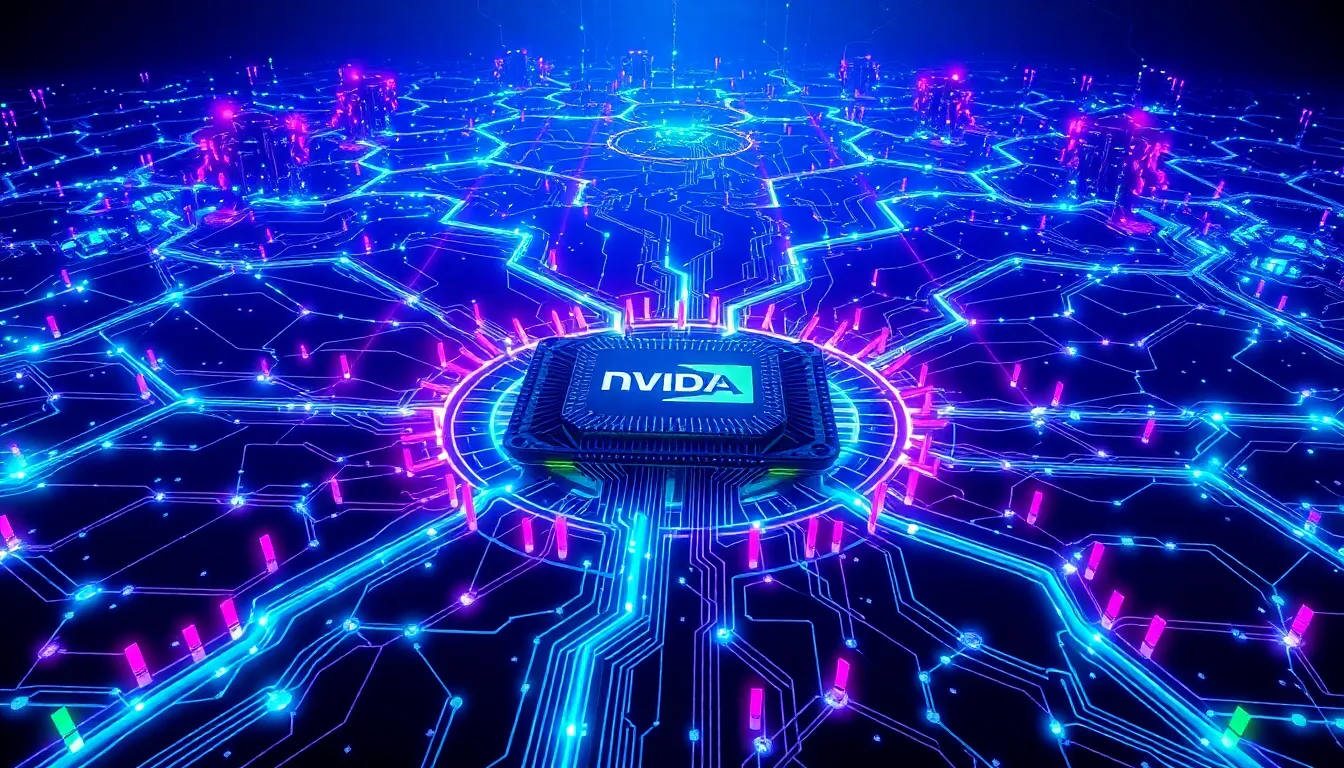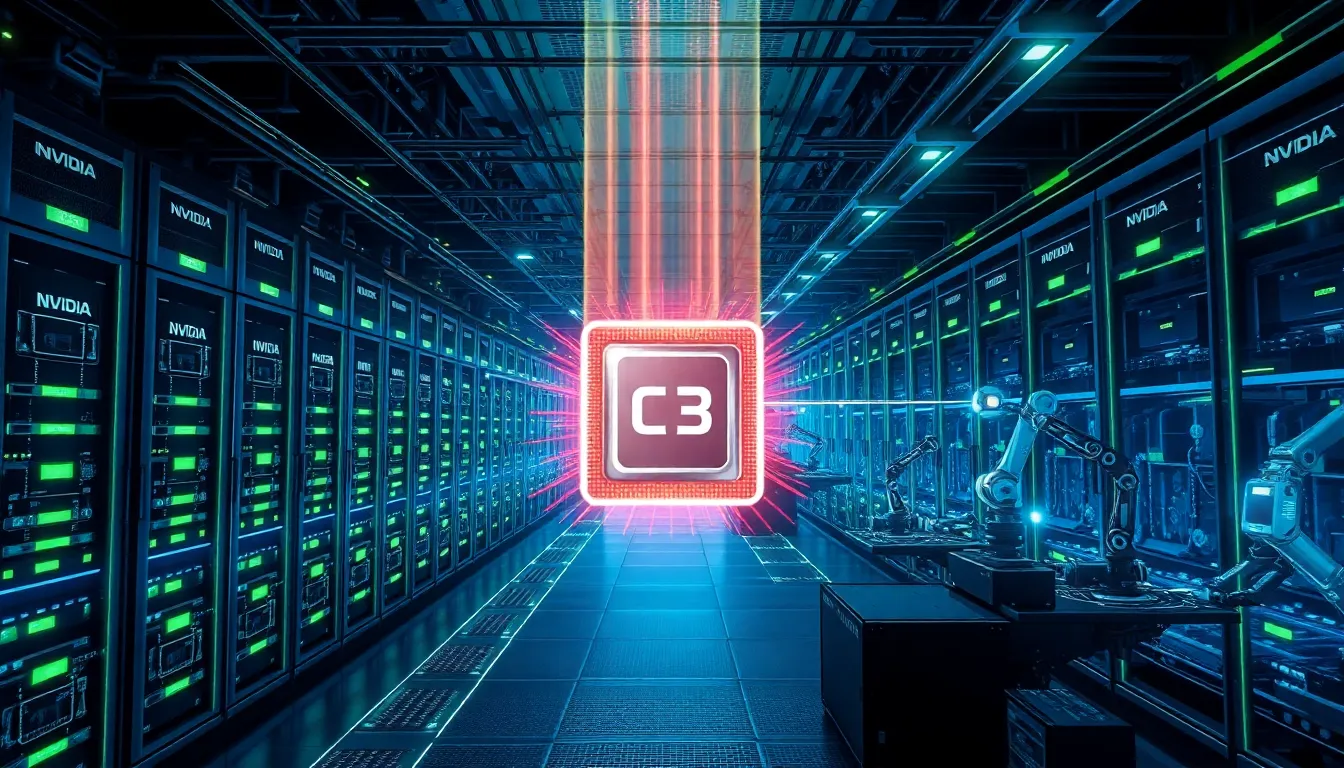Nvidia’s Landmark Moves, characterized by a strategic pivot to AI and data centers, have propelled the company to unprecedented financial heights and a foundational role in the global AI revolution. This transformative reorientation has resulted in staggering revenue growth, a monumental market valuation, and an unassailable lead in critical computing technologies.
Key Implications
- Explosive Financial Growth from AI: Nvidia’s pivot to AI and data centers has generated unprecedented financial success, evidenced by $18.4 billion in Q4 FY2024 data center revenue and a $1 trillion market capitalization achieved in May 2023.
- Dominance in AI Processing Hardware: The company commands over 90% of the data center AI processor market with innovations like the H100 GPU, offering significantly faster AI training and inference, supported by new architectures such as the Grace Hopper Superchip.
- Unassailable CUDA Software Ecosystem: Nvidia’s CUDA platform, with 4 million developers and widespread integration, forms a critical competitive moat, powering 90% of global supercomputers and accelerating deep learning with libraries like cuDNN.
- Strategic Expansion into Full-Stack Computing: Key acquisitions, including the $7 billion Mellanox deal, and development of BlueField DPUs have extended Nvidia’s capabilities beyond GPUs into high-performance networking, solidifying its role as a comprehensive computing provider.
- Foundational Role in the Metaverse: Through its Omniverse platform, Nvidia is enabling the industrial metaverse, allowing enterprises like the BMW Group to reduce factory planning time by 30% via advanced 3D simulation and digital twins.

Data Center AI Acceleration Fuels $18.4 Billion Quarterly Revenue and $1 Trillion Milestone
Nvidia’s strategic pivot to artificial intelligence (AI) and data centers has fundamentally reshaped its business model. This bold and prescient shift established the company as a foundational provider for the global AI revolution. This pivotal transformation has directly translated into unprecedented revenue growth and a monumental market valuation. These are the remarkable outcomes of Nvidia’s Landmark Moves in a rapidly evolving technological landscape.
In Q4 FY2024, Nvidia’s Data Center revenue soared to an astonishing $18.4 billion. This impressive figure represented 83% of the company’s total revenue, highlighting a significant shift in its core business focus. Furthermore, this segment experienced a remarkable 409% year-over-year growth, underscoring the immense global demand for its specialized AI processing capabilities. Such rapid expansion is a clear indicator of Nvidia’s success in anticipating and capitalizing on the burgeoning AI market’s needs.
Unprecedented Financial Ascendance
Nvidia’s financial trajectory has been nothing short of spectacular, solidifying its position as a dominant force in the technology sector. The company achieved a staggering $1 trillion market capitalization in May 2023. This monumental milestone reflects profound investor confidence in Nvidia’s long-term growth prospects within the dynamic AI landscape. This achievement follows an incredible 900% market cap growth since 2018, demonstrating a consistent and aggressive upward trend driven by strategic foresight and execution.
Shareholders have also reaped substantial rewards from Nvidia’s performance. The company’s share price increased by an impressive 238% throughout 2023 alone. This rapid appreciation reflects strong market belief in Nvidia’s pivotal role in enabling the AI future. Furthermore, the company reported a diluted Earnings Per Share (EPS) of $4.93 for Q4 FY2024. This figure marked an astounding 765% year-over-year increase, signaling robust profitability alongside its revenue expansion. These financial indicators collectively paint a clear picture of a company leading its industry.
Dominance in AI Processing Technology
At the core of Nvidia’s financial success is its unparalleled technological innovation, particularly in Graphics Processing Units (GPUs). These GPUs are specifically optimized for intensive AI workloads. The H100 GPU stands as a prime example of this leadership, offering significantly enhanced performance for crucial AI applications. For instance, the H100 GPU delivers up to 9x faster AI training speeds compared to previous generations. This drastically cuts down development times for complex machine learning models.
Beyond AI training, the H100’s capability extends to inference, where it provides up to 30x faster performance. Inference is the process of using a trained AI model to make predictions or decisions. This acceleration is critical for deploying AI applications efficiently in real-world scenarios. Examples range from enabling autonomous vehicles to powering advanced natural language processing systems. Such superior performance metrics explain why Nvidia commands an overwhelming market share in this specialized domain.
Indeed, Nvidia boasts over 90% of the data center AI processor market share. This near-monopoly position is a direct outcome of Nvidia’s Landmark Moves in both hardware innovation and comprehensive software ecosystem development. The company’s CUDA platform provides developers with essential tools for harnessing GPU power, further cementing its industry standard. This technological leadership ensures that Nvidia remains at the forefront of AI infrastructure globally.
The Foundational Role in the AI Revolution
Nvidia’s strategic pivot was not merely an adjustment; it was a complete reorientation towards becoming the undisputed engine of the artificial intelligence revolution. By prioritizing the development of specialized hardware and a comprehensive software ecosystem for AI, Nvidia positioned itself as an indispensable partner. This partnership extends to enterprises, research institutions, and cloud providers worldwide. Its foundational role means that as AI continues to expand into new sectors, Nvidia’s technology will underpin much of that monumental growth.
The vast adoption of Nvidia’s platforms spans diverse industries, highlighting its widespread impact across the global economy. Sectors like cloud computing, scientific research, and enterprise AI heavily rely on Nvidia’s powerful solutions. Companies seeking a competitive advantage through AI consistently turn to Nvidia for the necessary computational power. This widespread dependence ensures a continued revenue stream and reinforces the company’s strategic importance in the rapidly evolving digital landscape. The enduring impact of Nvidia’s Landmark Moves will shape the future of technology for decades.
In essence, Nvidia has not just built products; it has built an entire ecosystem that fuels the AI economy. Its GPUs are the workhorses behind breakthroughs in everything from medical diagnostics to climate modeling. This strategic foresight and relentless innovation have created a self-reinforcing cycle of demand and development, solidifying its market leadership. The company’s consistent delivery of groundbreaking technology continues to drive its financial success and influence on the broader tech world.

The Unyielding Grip on GPUs, Fortified by a 4 Million-Developer Software Advantage
Nvidia maintains an exceptionally strong dominance in the discrete GPU market, a position originally established and fortified through its unparalleled success in gaming. This hardware supremacy is strategically complemented by the pervasive and indispensable CUDA software ecosystem. This dual approach solidifies Nvidia’s long-term competitive edge, particularly in high-performance computing (HPC) and artificial intelligence (AI) applications. The latest figures underscore this powerful market position, reflecting an increasing stronghold in a rapidly evolving technological landscape.
Recent market data highlights Nvidia’s commanding lead. The company secured an astounding 80% market share of discrete GPU unit shipments in Q4 2023. This figure represents a significant increase from its 73% market share in Q4 2022. Such growth illustrates the continued demand for Nvidia’s graphical processing units across various sectors. These impressive statistics confirm Nvidia’s position as a dominant force.
Gaming Prowess Fuels Hardware Supremacy
Nvidia’s foundational strength in gaming has been a crucial stepping stone to its broader market dominance. High-end consumer models, such as the GeForce RTX 4090 and RTX 4080, exemplify the company’s commitment to performance and innovation. These advanced GPUs not only cater to the enthusiastic gaming community but also showcase the cutting-edge capabilities of Nvidia’s hardware. This consistent leadership in gaming hardware sets a high standard for competitors.
The financial contributions from gaming remain substantial for Nvidia. The company reported $2.86 billion in gaming revenue in Q4 FY2024, which accounted for 15% of its total revenue. This significant revenue stream provides a stable base amidst the explosive growth in its data center division. Furthermore, this gaming segment experienced a robust 56% year-over-year increase in revenue, demonstrating healthy consumer demand and the ongoing appeal of Nvidia’s GeForce ecosystem. These figures are critical components of Nvidia’s Landmark Moves in the market.
CUDA: The Software Ecosystem’s Unassailable Fortress
Beyond hardware, Nvidia’s true strategic advantage lies within its CUDA platform. CUDA (Compute Unified Device Architecture) is a parallel computing platform and programming model developed by Nvidia. Launched in 2006, CUDA allows software developers to use a GPU for general-purpose processing, enabling significant acceleration of compute-intensive applications. This platform transformed GPUs from specialized graphics processors into versatile engines for scientific and AI workloads. To explore broad AI applications, you can discover AI innovations and their practical impact across industries.
The scale of the CUDA ecosystem is immense and creates a formidable barrier to entry for potential competitors. The platform now supports over 40 million lines of code, illustrating its deep integration into countless applications and systems. Crucially, Nvidia boasts 4 million registered CUDA developers worldwide. This vast community of experts is continually developing and optimizing software for Nvidia GPUs. This developer base fosters an intricate network effect, making it incredibly difficult for alternative hardware ecosystems to gain traction.
CUDA’s indispensability is most evident in the fields of high-performance computing and artificial intelligence. A staggering 90% of the top 500 supercomputers globally utilize Nvidia GPUs in conjunction with CUDA. This widespread adoption underscores CUDA’s critical role in powering advanced scientific research, complex simulations, and cutting-edge AI development. The platform’s specialized libraries, such as cuDNN (CUDA Deep Neural Network library), further accelerate deep learning. CuDNN is known to accelerate deep learning training by an impressive 5x to 10x, drastically reducing computation times for AI models. When considering the efficiency of various AI tools, it’s interesting to compare AI writing tools like Gemini and ChatGPT, which benefit from such accelerated training.
The combined force of Nvidia’s dominant hardware market share and the entrenched CUDA software ecosystem creates an unassailable long-term competitive edge. This symbiosis ensures that as demand for high-performance computing and AI continues to skyrocket, Nvidia remains at the forefront, providing the essential tools and infrastructure. These strategic Nvidia’s Landmark Moves solidify its position, making the CUDA platform not just a product, but a pervasive industry standard. The difficulty for any competitor to replicate such a comprehensive and deeply integrated platform is immense. For those interested in how AI is changing content consumption, discover personalized AI feeds.

Beyond Core GPUs: $7 Billion Acquisitions and Metaverse Ventures
Nvidia, long celebrated for its graphics processing units (GPUs), has strategically diversified its portfolio, signaling an ambition far beyond its core competency. This shift positions the company as a full-stack computing provider, expanding its influence from advanced data center networking to the nascent metaverse. These Nvidia’s Landmark Moves underscore a commitment to shaping the future of computing across multiple transformative domains. The company’s vision involves integrating hardware, software, and services to create comprehensive platforms for next-generation workloads.
Expanding Data Center Dominance Through Strategic Acquisitions
The cornerstone of Nvidia’s data center expansion was the acquisition of Mellanox Technologies. This critical move, completed for an astounding $7 billion in April 2020, brought a leader in high-performance networking into the Nvidia fold. Prior to the acquisition, Mellanox held over 50% InfiniBand market share, a testament to its prowess in enabling high-speed, low-latency communication essential for modern data centers. This strategic integration has significantly bolstered Nvidia’s capabilities, allowing for seamless synergy between its powerful GPUs and Mellanox’s networking solutions.
The impact of the Mellanox acquisition is evident in Nvidia’s financial results. In Q4 FY2024, data center networking revenue, largely driven by Mellanox products, exceeded $1 billion. This highlights how strategic acquisitions can quickly translate into substantial financial gains and market leadership. Mellanox’s technologies, particularly its InfiniBand and Ethernet solutions, are crucial for scaling AI and high-performance computing (HPC) infrastructures.
Further solidifying its networking capabilities, Nvidia introduced the BlueField Data Processing Unit (DPU). This innovative technology can offload a remarkable 100% of the CPU’s network processing load, freeing up valuable CPU cycles for application-specific tasks. By handling networking, storage, and security functions at the network edge, BlueField DPUs enhance efficiency and performance in cloud and enterprise data centers. This advancement is vital for supporting the immense data throughput required by AI models and complex simulations, ensuring optimal system performance.
Pioneering Next-Generation Computing Architectures
Beyond acquisitions, Nvidia has invested heavily in developing entirely new computing architectures. The Grace Hopper Superchip stands as a prime example of this innovation. It integrates a Grace CPU with a Hopper GPU, enabling an unprecedented 900 GB/s CPU-GPU interconnect bandwidth. This incredibly high bandwidth is crucial for rapidly moving vast datasets between the CPU and GPU, which is often a bottleneck in many traditional systems. Such tight integration is particularly beneficial for large language models and scientific computing workloads, where data transfer speed is paramount.
The Grace CPU itself is engineered for superior performance and efficiency. It offers up to 2.5x more memory bandwidth compared to traditional server CPUs. This enhanced memory bandwidth is instrumental for workloads that are memory-bound, such as complex simulations, data analytics, and high-performance computing applications that frequently access large datasets. These architectural innovations, part of Nvidia’s Landmark Moves, are designed to accelerate the most demanding AI and HPC tasks, pushing the boundaries of what is computationally possible for complex problem-solving.
Building the Foundation for the Metaverse with Omniverse
Nvidia’s ambition extends even further, into the realm of virtual worlds and digital twins with its Omniverse platform. Omniverse is a scalable, open platform for connecting and building 3D virtual worlds, designed to foster collaboration and simulation. It allows creators and enterprises to develop and operate metaverse applications, creating a new dimension of interactive experiences. This platform represents a significant step towards enabling the industrial metaverse, where complex simulations and digital prototypes can be created and tested within a rich, physically accurate virtual environment.
The adoption rate for Omniverse highlights its growing influence across various sectors. Over 700 enterprises and 100,000 creators have already embraced the platform, signaling strong industry recognition and a burgeoning ecosystem. This widespread adoption underscores Omniverse’s potential as a foundational technology for the metaverse. For instance, the impact of AI in various sectors is also seen here, as Omniverse leverages AI for its simulation and generative capabilities, enhancing realism and efficiency in virtual environments.
A compelling real-world example of Omniverse’s transformative impact comes from the automotive industry. The BMW Group uses Omniverse to reduce factory planning time by 30%. By creating a digital twin of their factories, BMW engineers can simulate and optimize production processes in a virtual environment before physical implementation. This not only saves significant time and resources but also allows for greater flexibility and innovation in manufacturing. The ability to simulate complex environments can even extend to sustainable practices, optimizing resource use and energy consumption in various industrial applications.
Nvidia’s journey to becoming a full-stack computing company is characterized by these strategic investments and groundbreaking innovations. From bolstering data center infrastructure with key acquisitions and advanced DPUs, to redefining computing architectures with Grace and Hopper, and finally, laying the groundwork for the industrial metaverse with Omniverse, Nvidia continues to redefine its role in the global technology landscape. The company’s proactive approach in these diverse areas solidifies its position as a critical enabler of future digital transformation, including advancements in personalized AI applications and beyond.
Featured image generated using Flux AI
Source
Jon Peddie Research, “Q4 2023 Discrete GPU Market Share Report”
Nvidia Corporation, “Q4 FY2024 Earnings Release and Investor Presentation”
Gartner, “Artificial Intelligence Chip Market Forecast 2023-2027”
Nvidia Developer Blog, “CUDA: The Journey of GPU Computing”
IDC, “High-Performance Computing Interconnect Market Analysis 2023”
CNBC, “Nvidia Surpasses $1 Trillion Market Cap”
BMW Group News, “BMW Uses Nvidia Omniverse for Digital Factory Planning”
AnandTech, “Nvidia Grace CPU and Grace Hopper Superchip Deep Dive”
